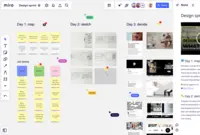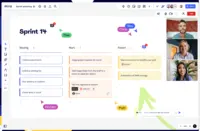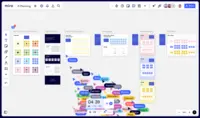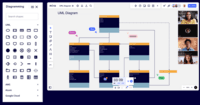Overview
What is Miro?
Miro provides a visual workspace for innovation that enables distributed teams of any size to dream, design, and build the future together. Today, Miro counts more than 60 million users in 200,000 organizations who use Miro to improve product development…
Miro for Digital Collaboration
Miro Review.
Miro is great tool for collaboration and to increase your team's efficiency.
Bring you and your teammates on the same page.
A fantastic all-round tool for any research project
Miro - collaborating efficiently
Miro: your goto tool for team productivity.
Miro for Systems Eng Team.
Miro is a Must!
Product Manager's Review
Workflow definition and explanation
Process guidelines
Miro for cross collab is great!
My experience with Miro
I've used Miro …
Miro - Just Use It, Its Worth Your Time
- Project Management uses …
Key Catalyst leadership productivity tool
TrustRadius Insights
Awards
Products that are considered exceptional by their customers based on a variety of criteria win TrustRadius awards. Learn more about the types of TrustRadius awards to make the best purchase decision. More about TrustRadius Awards
Reviewer Pros & Cons
Video Reviews
3 videos
Pricing
1. Free - To discover what Miro can do. Always free
$0
2. Starter - Unlimited and private boards with essential features
$8
3. Business - Scales collaboration with advanced features and security
$16
Entry-level set up fee?
- Setup fee optionalOptional
Offerings
- Free Trial
- Free/Freemium Version
- Premium Consulting/Integration Services
Starting price (does not include set up fee)
- $10 per month per user
Product Details
- About
- Integrations
- Competitors
- Tech Details
- Downloadables
- FAQs
What is Miro?
Miro provides a visual workspace for innovation that enables distributed teams of any size to dream, design, and build the future together. Miro is used to improve product development collaboration, to speed up time to market, and to make sure that new products and services deliver on customer needs.
Miro's visual workspace enables distributed teams to come together to synthesize information, develop strategy, design products and services, and manage processes all throughout the innovation lifecycle.
A Miro board displays hundreds of collaborators moving through the space as named cursors on the screen designing, contributing ideas, providing feedback, and co-creating together with shared tools and information.
To learn more, please visit https://miro.com
Miro Features
- Supported: Drawing
- Supported: Marker Colors
- Supported: Mind Mapping
- Supported: Templates
- Supported: Drag-and-Drop
- Supported: Voting
- Supported: Commenting
- Supported: CMS Integrations
- Supported: Sharing
- Supported: In-Browser
- Supported: Desktop App
- Supported: Mobile App
- Supported: Collaborative Editing
- Supported: Task Management
- Supported: Notes and Comments
- Supported: Styles and Themes
- Supported: Image Import
- Supported: Custom Icons
- Supported: File Formats
- Supported: Cloud Storage Integration
- Supported: Mobile Application
- Supported: Desktop Availability
- Supported: Status Updates
- Supported: Instant Messaging
- Supported: Activity Feed
- Supported: Notifications
- Supported: Comments and Voting
- Supported: Discussions
- Supported: User Directory
- Supported: Online Status of Coworkers
- Supported: File Sharing
- Supported: Document Collaboration
- Supported: Version Control
- Supported: Tagging
- Supported: Knowledge Base
- Supported: Surveys
- Supported: Task Management
- Supported: Calendar
- Supported: Search
- Supported: Mobile
- Supported: Multi-Language Support
- Supported: Moderation
- Supported: User, Role, and Access Management
- Supported: Performance and Reliability
- Supported: Integrated Communications
- Supported: Native Communications
- Supported: Board Overview
- Supported: Screen Sharing
- Supported: Pre-made Templates
- Supported: Custom Templates
- Supported: Required Hardware
- Supported: Bring Your Own Device
- Supported: Permissions
- Supported: Talktrack
Miro Screenshots
Miro Videos
Miro Integrations
- Zoom Workplace
- Adobe XD
- Microsoft Teams
- Slack
- Dropbox
- Box
- Google Drive
- Zendesk Suite
- GitHub
- RingCentral Events
- BetterCloud
- monday.com
- Jira Software
- Azure DevOps Services
- Atlassian Confluence
- Trello
- HubSpot Marketing Hub
- Salesforce Sales Cloud
- Asana
- Webex Meetings
- Microsoft 365
- Google Workspace
- Giphy
- Figma
- Airtable
- Google Calendar
- Google Meet
- Notion
- dscout
Miro Competitors
Miro Technical Details
| Deployment Types | Software as a Service (SaaS), Cloud, or Web-Based |
|---|---|
| Operating Systems | Unspecified |
| Mobile Application | No |
| Supported Languages | English, French, Spanish, Japanese, German |
Miro Downloadables
- Miro is a workspace built for innovation. This download describes how Miro provides a full suite of capabilities for diagramming, wireframing, real-time data visualization, workshop facilitation, interactive presentations, and agile practices.
- About the business value of Miro per analysts at IDC This download describes what IDC analysts believe to be the Business Value of Miro.
Frequently Asked Questions
Comparisons
Compare with
Reviews and Ratings
(6852)Community Insights
- Business Problems Solved
- Pros
- Cons
Miro has been widely employed for various purposes, including brainstorming and facilitating team discussions. Its use extends to enhancing presentations with visual cues instead of traditional slides. The platform aids in efficient sprint planning and project management while aligning teams effectively. Users have harnessed its GenAI features for creating diagrams, compiling meeting notes, and conducting design tasks such as mapping user flows and journeys. Miro also serves as a crucial tool for customer research activities, from initial planning and note-taking to the final synthesis. Moreover, it caters to virtual collaboration needs by supporting design reviews, workshops with external customers, and fostering knowledge sharing within design teams.
Template Variety: Users have expressed appreciation for Miro's diverse range of template layouts tailored to different project needs, enhancing creativity and organization. The platform's extensive template options cater to various preferences and requirements, offering a wide selection to suit diverse project scopes and styles.
Real-time Collaboration: Reviewers have highlighted the platform's real-time engagement and updates as beneficial for fostering teamwork across different time zones, facilitating efficient collaboration and communication among team members. This feature ensures that all stakeholders stay updated with the latest developments promptly.
Effective Tools: Many users find the AI delete background tools effective for sketch uploads, significantly improving the overall user experience by simplifying tasks like image editing. The tool streamlines workflows and enhances productivity when working on visual content within the platform.
Performance Issues: Reviewers have frequently reported significant performance problems with large boards taking a long time to load, negatively impacting the user experience. This issue hampers productivity and frustrates users trying to work efficiently.
Limited Drawing Capabilities: Users find the drawing capabilities, especially for shapes, to be restrictive and have requested more variety in shapes and the ability to save brand colors. The current limitations hinder creativity and design flexibility on the platform.
Difficulty in Board Organization: Some users express confusion when organizing boards by department, struggling with determining the correct placement for new boards. This lack of clarity disrupts workflow efficiency and makes it challenging to maintain an organized workspace.
Attribute Ratings
- 9.1Likelihood to Renew99 ratings
- 8.8Availability8 ratings
- 8.8Performance7 ratings
- 8.1Usability72 ratings
- 6.4Support Rating27 ratings
- 9.7Online Training4 ratings
- 8.6Implementation Rating3295 ratings
- 9.8Configurability3 ratings
- 9Product Scalability8 ratings
- 7.4Ease of integration3640 ratings
- 8Vendor pre-sale1 rating
- 10Vendor post-sale1 rating
Reviews
(1-25 of 2440)- Provides numerous templates and the ability to customize them.
- Can easily integrate with keynote and notion.
- Can export the whole whiteboard for later use.
- Users can add sticky notes to add additional comments.
- Improve the time it takes to import a whiteboard from an existing file.
- And it is not a drawback but they should add more templates.
Bring you and your teammates on the same page.
- Ability to handle extremely large canvas size
- Integration with other Apps and Plus ins
- Auto alignment and sizing guidance
- With regards to text size at a given zoom level, once the board is initiated at a certain zoom level, it becomes very difficult to change the level.
- During screen sharing, Miro often goes into 'syncing' mode. The lag is pretty high a lot of times.
- Wireframe library is not so great currently.
Some of the users try using it for getting a wireframe or tracking progress or as document creator. After intese efforts the outcome does look prettier but from business perspective it does not make sense to put so much effort just to improve aesthetics. Might make sense for organisations who need to show these to clients on a regular basis.
- Ability to create and group content visually
- Creating flows is seamless with the simplicity of creating shapes and anchoring to eachother.
- Conducting workshops is fantastic and it allows for easy collaboration.
- This is more a user problem, but I find I can have very messy miro boards, and at times I'm not sure the best way to organise them - have everything in one project or create several projects for different tasks?
- I would like the ability to add larger images, as at times I have screenshots of web pages and Miro doesn't accept them past a certain pixel dimention.
Miro: your goto tool for team productivity.
- Rapid capture of feedback and ideas.
- Creation of lo-fi mockups of potential solutions.
- Collaborative iteration over ideas.
- Organizing messy information into an understandable structure.
- Enables everyone to participate.
- Consistency of icons/images in IconFinder.
- Prototyping tools could do with a revisit.
- Consistency of scale between different boards, making it easier to copy/paste between.
Miro for Systems Eng Team.
- Ease of diagramming.
- Allowing for team ideation and voting.
- Importing/pasting of outside content.
- Rotate objects.
- Snap objects to grid - both shapes as well as better auto-organization.
- Offline mode.
Miro is a Must!
- Brainstorming
- Workflows
- Mind map
- Process improvement
- Easier integration into microsoft suite
Strategic planning
Business improvement modelling
Product Manager's Review
Workflow definition and explanation
Process guidelines
- Explaing Product workflows and scenario mapping
- Team collaboration for distributed teams
- Miro has intuitive UI to add/edit elements
- Zoom-in and zoom out views
- Importing slides in an editable content (not as picture)
- More templates for idea sharing and brainstorm exercise
- Voting as a capability for team to vote their choice on any item
My experience with Miro
I've used Miro to help manage everything from large multi year technology migrations to small projects that are finished in a week.
- Multi user collaboration
- Help meet organize my data
- Make it easy to share with others
- Microsoft Teams integrations
- I haven't seen GitHub integrations
Miro - Just Use It, Its Worth Your Time
- Project Management uses that allow me to incorporate other ideas and visuals into the flow of kanban or otherwise
- Process mapping
- Cloud architecture
There are more - essentially what I’ve found is that it is somewhat of a user friendly version of a variety of other tools such as lucid chart, trello, visio and more
- Collaboration
- Digital / Virtual brainstorming
- Variety of options and AI integration
- Leveraging AI to prompt ideas and generate a board or variety of elements for the board - this may already be deployed, but I haven’t seen access to it yet. It would accelerate the time to set up and get started
- icons are always a thing in collaboration and even consulting. It would be really neat to drop an example style of an icon in, and have Miro convert all pre-existing icons to a template style dropped in. Not sure how this would be accomplished but I imagine the fidelity of users would increase if organizations had an easier time doing something like this or similar
- The biggest barrier I’ve learned from using Miro with others is simply the adoption element. For some reason people see it as “yet another tool to learn and stumble around figuring it out” - Miro has done a good job walking through how to use it, but there’s still that hurdle of people adoption to get through. I’m not sure how this gets accomplished, but maybe something to think about - “how to make it easier"
Less appropriate - maybe not the best for executive meetings or with showing anything to the c suite. I don’t think any of the c suite would ever use Miro, per se; though I’ve had luck using it with VP level individuals at fortune 500 companies. But again, wouldn’t use it for, say, a quarterly earnings presentation :)
I love Miro!
- Collaboration across multiple people in a meeting
- Flexibility/Customization to be used in the best way for any particular user
- Sticky notes are simple, yet effective
- Images saved as JFIF cannot be uploaded to Miro because Miro does not accept JFIF format, which is frustrating because JFIF is a type of JPEG image
- Stickers and emojis are limited
- When selecting multiple objects, instead of filtering by object *type* (image, shape, sticky note, connection line), it would be helpful if Miro could also have the option to instead break them down into individual objects. (For example, if I select 3 shapes and an image, sometimes I want the option to select one very specific shape instead of all the shapes at once).
- Allows me to visually show process work, quickly.
- Allows many others to participate (with minimal learning curve).
- Allows non-creatives to contribute in engaging ways.
- Text tool variations could be improved/streamlined.
- I wish there were more built-in/on-screen tools (with a customizable toolbar for new Miro users).
- More templates.
Great tool for those who love whiteboards
- Brainstorming and iteration
- Process documentation
- Meeting Facilitation
- adding shapes to a process map that spans more than one swimlane (Miro automatically adjusts my swimlanes and I don't want that)
Miro is the perfect tool for companies that need asynchronous and visually pleasing communication
- building user journeys
- brainstorms
- team work
- presentations
- presentations
- presentations
Miro Whiteboard Tool
- Simple controls that are easy to get started with
- Infinite canvas
- Use of frames
- Ability to show/hide content
- Restricting the ability for participants to unintentionally manipulate parts of the board that are meant to be static
- Integration with PowerPoint
- Layers within frames
- Visual collaboration on diagrams, charts, and other visual content in real time.
- It facilitates design thinking workshops.
- Roadmaps and timelines planning.
- Improve the mobile app to offer a smoother and more intuitive user experience.
- Expand the library of templates for different use cases and industry-specific cases.
- An offline mode that allows users to access and work on boards even when they don't have an internet connection, with changes syncing once they reconnect.
Miro is amazing
- Design thinking templates
- Cross-functional collaboration
- Facilitation
- Easier exporting
- Single sign-on complexity
I would not use it as an individual trying to capture notes.
Miro works to put your mind on screen and build a plan!
- Result chains
- Process documentation
- Applying thought to screen
- Works with the Jira tool
- My needs have not outgrown Miro, and it does everything I need it to do very well
Great tool for product and user flow planning
- Easy navigator and board visibility
- Common shapes and elements that I need to use are available
- Resizing makes it very flexible
- I'd love to see Grammarly (or some sort of autocorrect tools) on top of Miro
- Arrows and lines are not easy to use and sometimes drag my frames
- I'd love to see more real product shapes and full components (not just buttons)
- Benchmarking please! ideas for wireframes etc
I also like to use it for brainstorming, when everyone can access and put their notes on a shared board.
It could be enhanced in that sense and allow more collaborative options such as voting
Miro for design thinkers
- Generating sticky notes - most people can figure that out w/ no/little orientation
- process diagraming - this has gotten much better in the last year
- wireframing websites and user interfaces
- icons - they used to stink, but now they are WAY better - a small but important thing
- Some objects that support text don't support formatting (i.e. bullets) and that can be annoying, especially when you don't test it first and then all of the sudden you need them. I wouldn't expect support for stickies, but pretty much all other objects.
- the product is doing a really good job of releasing new features, i'm not really sure I have more suggestions
It's not quite yet fully supportive of interactive prototypes though, that's the direction I'd like to see it go. Something akin to Adobe XD's capabilities in that space.
How Miro helps me be a better designer
- Offer unlimited space on their boards
- Enables colaborative work
- Provides conversion of content to other formats
- It keeps dislogging from time to time and relogging on is time consuming
- Large boards take a long time to load
- The drawing of shapes is quite limited
Miro - A great tool to bring together a company
- Organization
- Templates
- Collaboration
- Different Shapes
- Saving Brand Colors
- Deleting out presaved colors
Miro & Me
- There is a wonderful variety of template layouts relevant to project needs
- Project access and organization are paramount to ensuring the right people see the right things
- Miro promotes both real-time engagement and updates to make sure people in other time zones can access the most updated information
- If the organization has boards divided up by department, it can be confusing to know where to put a new board/how to make sure it winds up in the correct place for teammates to access based on their permissions
- In some cases, users may not understand the best template to use to meet their needs. For example, I used the mind-map template frequently, but a colleague had no clue how to use it and felt there was no hint or "pro-tip" on how they could benefit from using it.
- This is purely aesthetic, but if more colors could be implemented into things like the sticky notes, that would be great. Sometimes, there were more people working on a project than there were colors available to differentiate between who was sticking what feedback in the project.
Miro Review
- Its the only tool that my organization permits (that does what it needs to do)
- Somewhat-simple interface
- Infinite "space"
- AI - "delete background" tools work well for sketch uploads
- Sticky notes
- Video formats not supported
- Multi-uploads not supported
- Sketching directly in Miro is horrible (ie "Pen" tools are basically useless). Look to Procreate for a better experience
- Connection lines default to snap to image - very annoying!
- Zoom/ Pan hotkeys could be more obvious (for novice users)
Not well Suited - Manually creating timelines. Grouping, aligning and moving objects feels clunky. Also not well suited for scenarios when sharing many LARGE images - it tends to slow down my entire computer when I open a Miro with too much content.
Why Miro Board in Staffing?
- Has a lot of options when creating the board.
- Once you get the hang of it, it is easy to use.
- Giving people access is easy to do as well.
- I think being able to edit the board is easier and not having to switch to the cursor on the board every time you want to move across it.
- Sometimes the board randomly gets messed up, and I'm not sure why.
User Review
- Idea flows
- house multiple forms of content
- organize thoughts
- templates that are more excel-like










